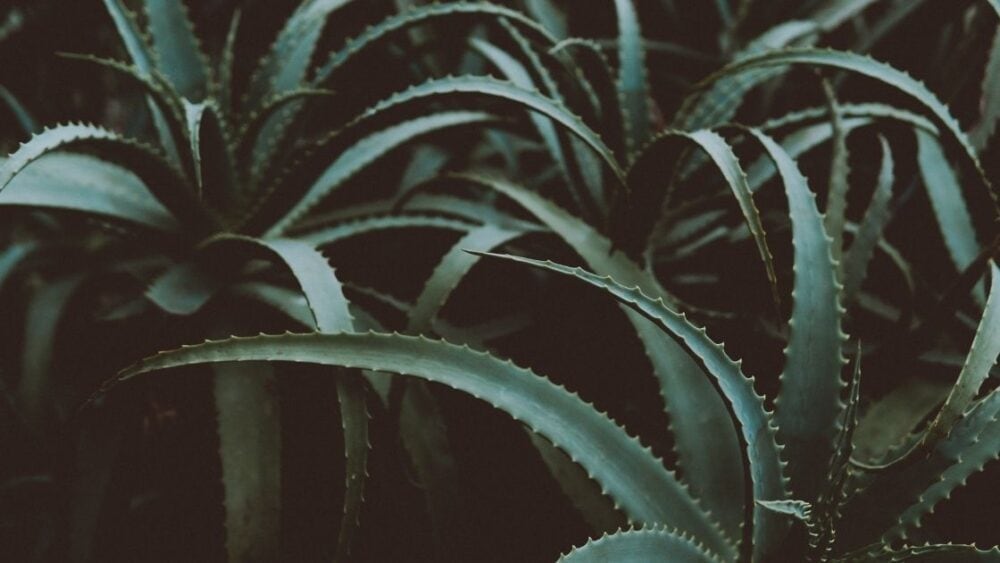
Browning is a problem that usually develops quickly, in a matter of days, making it very easy to identify the root cause – usually sudden sun exposure or overwatering. This symptom can be an early warning sign to reduce the watering frequency before the roots succumb to rotting. This isn’t common in other succulents, in which root rot can remain unnoticed until it’s too late.
Aloe is one of the fastest growing and easiest to care for succulents, but it can still display various symptoms of distress when the environmental conditions are sub-optimal. In this article, we’ll take a look at one of the most common visual symptoms exhibited by stressed Aloe plants – browning, or darkening of the leaves. We’ll explore why the problem occurs, how to identify the cause and how to solve it quickly before it progresses further.
Is Too Much Sun The Main Cause Of Browning In Aloe Plants?
Too much sun on its own will not usually lead to browning or leaf scalding/scorching in Aloe. Once mature Aloe plants are adapted to the direct sun, they can deal with strong sunlight without any issues.
Browse our Affiliate Products
The problem occurs when an Aloe plant that has been sitting indoors, or in a greenhouse, suddenly gets exposed to direct sunlight for more than a few hours. The plant is ill-equipped to handle this sudden stress, and browning occurs. The solution is to gradually acclimate your Aloe plants by giving them only thirty minutes to an hour of direct sunlight daily for a week and then increase the time gradually for one to two additional weeks.
Keep in mind that some darkening of the leaves is a normal part of the defense strategy of Aloe against the damaging rays of the sun – a little darkening or reddening is completely normal and is not a cause of concern.
What’s The Mechanism Behind Sudden Sunlight Exposure Leading to Browning?
Aloe, just like most other plants, has UVR-8 receptors, which get activated by the UV-B portion of the sunlight spectrum. Once those receptors get activated, the plant starts strengthening various anti-oxidant pathways and synthesizing sunscreen molecules to protect itself.
This process takes some time (especially in succulents like Aloe) and exposing the plant to strong sunlight before it has fully adapted leads to the accumulation of too much free radicals and non-metabolized sugars.
As a result, direct tissue damage occurs, which we see as browning. This is very similar to the sunburn we humans experience. Just like us, plants also adapt over the course of a few days or weeks, until eventually, prolonged exposure to the sun no longer poses any thread.
Overwatering & Other Causes of Browning
Overwatering is the second most common cause of leaf browning/darkening in Aloe. Gardeners often water their Aloe plants more when they are in the sun, which can make them wrongly conclude that the cause of the discoloration is sun stress, when it may in fact be the overwatering, or a combination of the two.
To avoid this trap, avoid judging the water requirements of Aloe by the weather conditions and always check the moisture of the soil surface – never water if the soil is still moist.
Browning caused by overwatering develops very quickly, but also disappears quickly when the watering frequency is reduced. However, if Aloe is watered too frequently for a few weeks, the darkening of the leaves can eventually progress to tissue and root rot.
This is one of the most common causes of death in Aloe plants, so make sure to always let the soil dry up a bit between each watering. Once the base of the rosette has rotted, the plant may be beyond saving.
Nutrient Deficiencies
(Phosphorus deficiency in particular) can also lead to darkening of the foliage, but usually the discoloration is more purple or reddish than brown. You can consider this as a possible cause only after overwatering and sun stress have been ruled out and only if the problem develops very slowly and gradually.
Apart from deficiencies, nutrient toxicity caused by excess fertilizer salts can also lead to discoloration, but this is rare.
Unfavorable Temperatures
can also lead to discoloration – freezing is an obvious cause that will inevitably lead to browning caused by cell rupture. Too high temperatures, especially without a night dip can lead to the whole plant taking on a ‘scorched’ look and becoming very pink and shriveled.
Aloe grows best with a large drop in temperature at night – this naturally happens when the plants are placed outdoors during the summer, but can be impossible to achieve indoors.
Repotting

Repotting can sometimes lead to temporary leaf browning – it’s not completely clear why this occurs, but it probably has to do with the higher or lower salt concentrations of the new soil, the increased watering after the procedure, or the inevitable damage to the tiny root hairs.
Either way, the problem is temporary and will disappear over the course of a few weeks. Make sure to give the plant a recovery period of a week or two, during which you should give it only indirect sunlight.
Sudden stressors
Stressors can sometimes cause leaf discoloration even if they are not harmful after the plant has gotten used to them. Sunlight obviously falls in this category, but so do a lot of other factors, including fertilization, temperature, watering and soil.
Are All Species of Aloe Affected The Same By Too Much Sun or Overwatering?
Some Aloe species (like Aloe Microstigma, Aculeata and many others) naturally become very red when given plenty of light. This is natural and unavoidable.
It can be difficult to distinguish healthy reddening and problematic browning apart in Aloe plants, but with some experience you’ll be able to do it. Many Aloe varieties develop a natural red tinge on their edges, while problematic browning commonly affects the base and middle of the leaves.
Different Aloe species can respond differently to overwatering and may not necessarily exhibit the same browning symptoms to the same degree.
Optimal Growing Conditions for Aloe
Aloe is very easy to care for, as long as you don’t overwater and give it plenty of sunlight. If the plant is kept happy, it will grow quite quickly and will produce several new leaves each month. Aloe plants also produce ‘pups’, which offer an easy way of propagation.
How Much Sunlight Is Needed?
Aloe needs at least 4-5 hours of direct sunlight every day to grow. In low-light conditions, it will stay the same size and eventually lose its bright green color, but can still survive for many weeks or even months.
What Temperature Is Ideal?
The ideal temperature range for Aloe is 55F to 85F (13 to 30C). If the temperatures go beyond those limits, leaf discoloration can occur, but usually the plant will simply start growing more slowly, as it halts photosynthesis in an effort to to limit the water loss through the leaves.
What Type of Soil Is Required?
Aloe likes well-draining soils rich in inorganic mineral additives like lava rocks and perlite. Organics like tree bark can also be incorporated to provide better aeration. Do not plant aloe in regular garden soil – it will quickly develop root and base rot due to the soil staying too wet for too long after each watering.
How Often Should You Water and How Much?
The general rules for watering succulents apply – let the soil dry up completely between each watering. Do not assume that Aloe needs more water if the weather is hot and only use at the moisture level of the surface of the soil as a gauge. During the winter, Aloe needs almost no water.
Can Aloe Be Planted Outdoors in Cold Regions?
Aloe can only withstand very light frost, so it shouldn’t be planted directly outdoors, unless you live in a USDA zone that doesn’t experience any significant frost (zones 10 and 11).
Dormancy
Dormancy in Aloe depends on the variety/cultivar. Most varieties will not enter true dormancy and will simply need less water in the winter due to the lower temperatures and slower water evaporation. Some varieties may enter summer dormancy, where they completely stop photosynthesizing in very hot weather to avoid dying of dehydration.
This dormancy can be prevented by still providing the plant with some water, but again – this is variety-dependent. Just keep in mind that it is possible for Aloe to enter dormancy both during the hottest and the coldest parts of the year, which will manifest itself as unexpectedly slow growth.
What Should I Do If My Aloe Starts Turning Brown?
Browning occurs very shortly after the plant is stressed (within days), making it easy to identify the cause. As we already discussed, overwatering and sun exposure are the two big causes to consider first.
After the plant is withdrawn from the direct sun and/or its watering frequency is reduced, the browning should disappear within a few weeks. Do not place sun-stressed plants in total darkness – paradoxically, they still need energy to repair the tissue damage, so provide them with indirect light or direct sunlight filtered through a window. Window glass will block out the damaging UV-B part of the spectrum.
How Well Does Aloe Deal With Unfavorable Growing Conditions?
Aloe is able to withstand harsh, hot conditions when acclimated and can go without water for a very long time. It doesn’t respond well to too much care – frequent watering and fertilization are much more likely to damage the plant than neglect.
Aloe can’t grow well in light-deficient conditions, but it won’t be killed by them quickly either. Overall, this is a difficult to kill plant – it has the advantage of being both drought-resistant and tolerant to some overwatering.
Final Thoughts
The two big causes of browning in Aloe plants are overwatering and sun damage. Both are easy to identify and if the problem is corrected on time, the affected plants should make a full recovery in a week or two.
Sometimes, the browning can appear out of nowhere, develop slowly and steadily worsen. In this case, the problem can be very difficult to pin-point and general, ‘umbrella’ solutions should be applied.
Those are repotting, changing the watering and fertilizer regimens, moving the plant around and increasing or decreasing the amount of light it gets. Some reddening of the leaves is normal if the plant receives more sunlight than usual.









